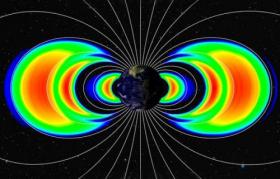Russian scientists, among which there are SINP scientists PhD. Alexander Drozdov and PhD. Ksenia Orlova, explained origin of the third radiation belt of the Earth observed in September 2012 in cooperation with their colleagues from Canada, USA and Korea. The study is published in journal Nature Physics, its brief content is presented in PhysOrg.
During about 50 years it was supposed that the Earth is surrounded by two electron radiation belts: inner (at the altitudes fom 1600 up to 13 thousands km) and outer (at the altitudes from 19 thousands up to 40 thousands km). The third radiation belt was observed at the inner edge of the outer belt at the altitude of about 19-22 thousands km from the Earth. It consists only of high-energy ultra-relativistic electrons (> 2 MeV) with high penetrating property.
The radiation belts of the Earth can produce serious hazard for the satellites and spacecrafts from negligeable failure of the equipment up to its full functional loss. "Better understanding of the nature of radiation in the near-Earth space will help us to protect people and equipment from the radiation hazard", - Yuri Shpritz, the Leader of an international group of scientists, currently Professor of Skolkovo Insitute of Science and Technology told us.
In order to study the nature of the third radiation belt of the Earth the international scientific team developed a model of the near-Earth radiation belts for the period from August 2012 till beginning of October 2012. Simulation was based on the data of ultra-relativisti electrons obtained by two identical satellites Van Allen Probes launched at the beginning of August 2012 and by other satellites.
The scientists found out that at the beginning of September 2012 ultra-relativistic electrons suffered significant losses due to the interactions with electromagnetic ion-cyclotrone waves and other processes. As a result the outer radiation belt emptied out as far as the inner edge forming a thin ring - the third radiation belt.
After the storm a bubble of cold plasma around the Earth, which is called plasmasphere, protected ultra-relativistic electrons from electromagnetic ion-cyclotronic waves and it allowed the third radiation belt to exist during a long time period.
Electrons of so high energy could not efficiently interact with plasma waves, which usually scatter electrons of lower energy. It also became a reason, why unltra-relativistic electrons did not disappear after the end of the storm and could stay at the orbit during four weeks.
As Yuri Shpritz told us: "I suppose that in this study we have only opened the top of the iceberg a little. We still have to understand mechanism of electrons acceleration up to such rates, where from they come to us and what's the difference between the radiation belts dynamics during the different types of storms in the near-Earth space".

